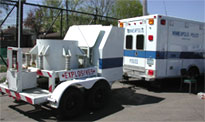 On On
December 8, 1930, Minneapolis police detectives, acting on a tip,
raided an apartment at 825 Eighth Street So., and wiped out a gunmen’s
hideout just organized in Minneapolis. Police arrested one man and also
seized a fully stocked gang arsenal, containing shotguns, pistols,
ammunition, tear gas pistols, and a submachine gun. After
the raid, Detectives Harry E. PARKER and Dan Noonan were “planted” in
the apartment in an attempt to capture the two Chicago “big shots” who
were being sought as the leaders of the gang. All
police detectives in the city were ordered out on special duty, under a
command to search every apartment house in the city and pick up every
man unable to give a full account of himself. The next
day, December 9th, about 6 p.m., Detectives PARKER and Noonan, still
hidden in the apartment, were preparing to eat their dinner when they
heard footsteps in the hallway and there was a knock at the door. Both
men drew pistols as they stepped against the wall so they would be
shielded by the door when it opened. Detective PARKER swung the door open and two men stepped in. “Detectives,”
PARKER said tersely as he and Noonan stepped from behind the door,
pistols leveled at the two men. The first man whipped a pistol from his
pocket and fired. Detective PARKER’s pistol barked simultaneously. Detective
PARKER dropped to the floor, a bullet in his abdomen. The gunman
staggered across the room, a bullet in his neck. He raised his pistol
again. Detective Noonan fired. The gunman dropped in his tracks, dead,
another bullet in his head. Detective Noonan then swung
like a flash to the second man. The second gunman had his hand inside
his coat, about to draw. “Drop ’em,” Noonan snapped. The second gunman
grinned, held up his hands. Noonan called police and an ambulance. Detective PARKER was rushed to General Hospital, and an emergency operation was performed. His condition was critical. He gave a fellow officer a statement. It read: “Do
you believe you are going to die, Parker?” “Yes, I think he got me. We
were waiting in the apartment. We heard a rap on the door. We waited.
The door opened and this one (the dead man) aimed at me and I aimed at
him. We both shot at the same time. Before I shot I told him we were
detectives. I had my gun in one hand and my badge in the other.” The
dead gunman was taken to the morgue. He was identified as Francis
Farley, alleged bank robber. The captive was identified as Walter
Fielund, who was turned over to Sioux City, Iowa authorities to face
bank robbery charges. James Kane, the first man
captured in the raid on the apartment, was identified as one of the
bandits who robbed the Layton Park State Bank of Milwaukee. Wisconsin
officials extradited him from Minneapolis to stand trial on the bank
robbery charge at Milwaukee. At the hospital, Detective
PARKER’s condition showed improvement, and he was moved from General
Hospital to St. Barnabus. There he continued to improve. The
week before Christmas, members of his family were planning on taking a
Christmas tree to the hospital and having their Christmas party at his
bedside. Detective PARKER’s condition took a turn for
the worse, however, and, according to hospital attendants, he said he
was afraid he was going to die. It was then that he decided he wanted
to be taken to his home, so that he might be with his wife and two
children for Christmas. “I don’t know whether I can
last until Christmas,” he smiled to hospital attendants shortly before
he was moved. “But I’ll try it.” Detective PARKER
became unconscious shortly after he reached his home at 3 p.m. on
December 23rd, and died from his wounds at 11 a.m. on Christmas Eve
day. The home is at 4150 Sheridan Avenue No. With him when he died were
his wife and son and daughter. In the next room was a Christmas tree.
Detective PARKER was 38 years old. He had been on the police department
for 10 years. He was promoted to the rank of detective on January 1,
1929. Interment took place on December 27, 1930 at Crystal Lake cemetery in North Minneapolis. |  On
On
